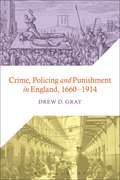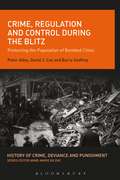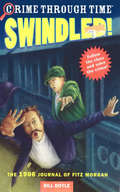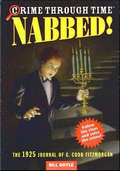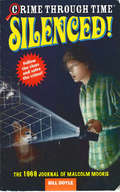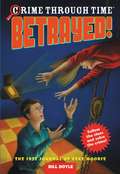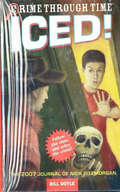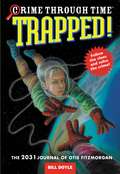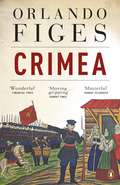- Table View
- List View
The Crime of Poison in the Middle Ages
by Franck CollardThis book will lead readers into a medieval culture of ambition, greed, and jealousy that motivated men and women to take the lives of individuals who trusted them. Collard examines the perception of the crime of poisoning in the West in medieval times, from about 500 to 1500 AD, exploring the ways the alleged crime was perceived in contemporary minds. His primary sources are chronicles that cover the entire medieval period and legal texts that are limited to the late medieval centuries. In order to portray the culture of murder by poisoning in the West, it was necessary to take into account Byzantine and Islamic documents as well as ancient texts such as the Scriptures and the writings of Roman historians, both of which were widely known in the Middle Ages.This book will lead readers into a medieval culture of ambition, greed, and jealousy that motivated men and women to take the lives of individuals who trusted them. In these pages, French medievalist Franck Collard examines the perception of the crime of poisoning in the West from about 500 to 1500. His primary sources of information are chronicles that cover the entire medieval period and legal texts that are limited to the late medieval centuries. In order to portray the culture of murder by poisoning in the West, he takes into account Byzantine and Islamic documents, as well as ancient texts such as the Scriptures and the writings of Roman historians, both of which were widely known in the Middle Ages.The resulting volume is concerned with the criminal actions that involve poison and not poison as such. Poisonous substances as such are described only when necessary for an understanding of a crime. What is important here is an examination of the ways the alleged crime was perceived in contemporary minds. Poisoning avoids the use of violence. It was committed without a drawn weapon or bloodshed in a world in which wounds, swords, knives, and clubs represented aggression and in which the flow of blood determined the gravity of the crime. Necessarily involving preparation and secrecy, it was often perpetrated treacherously during a meal, a particularly heinous act in a universe that was united by the companionship of a meal and the sociability of drinking. The special horror associated with poisoning resulted from the treachery of those close to the victim-and a sudden death that prevented a final confession of sins.
Crime Opportunity Theories: Routine Activity, Rational Choice and their Variants
by Mangai NatarajanOpportunity theories of crime seek to explain the occurrence of crime rather than simply the existence of criminal dispositions. They emphasize the fundamental element in the criminal act of opportunity: how this arises, how it is perceived, evaluated and acted on by those with criminal dispositions. This volume brings together influential research articles on opportunity theories of crime by leading theorists such as Cohen and Felson on routine activity theory and Clarke and Cornish on the bounded rational choice perspective. The articles also include more recent theoretical developments and studies of situational crime prevention of specific twenty-first century crimes. These articles attest to the sheer volume as well to as the richness and the variety of work designed to reduce crime that has forever changed the face of criminology and criminal justice.
Crime Opportunity Theories: Routine Activity, Rational Choice and their Variants (The\library Of Essays In Theoretical Criminology Ser.)
by Mangai NatarajanOpportunity theories of crime seek to explain the occurrence of crime rather than simply the existence of criminal dispositions. They emphasize the fundamental element in the criminal act of opportunity: how this arises, how it is perceived, evaluated and acted on by those with criminal dispositions. This volume brings together influential research articles on opportunity theories of crime by leading theorists such as Cohen and Felson on routine activity theory and Clarke and Cornish on the bounded rational choice perspective. The articles also include more recent theoretical developments and studies of situational crime prevention of specific twenty-first century crimes. These articles attest to the sheer volume as well to as the richness and the variety of work designed to reduce crime that has forever changed the face of criminology and criminal justice.
Crime, Policing and Punishment in England, 1660-1914
by Drew D. GrayCrime, Policing and Punishment in England, 1660-1914 offers an overview of the changing nature of crime and its punishment from the Restoration to World War 1. It charts how prosecution and punishment have changed from the early modern to the modern period and reflects on how the changing nature of English society has affected these processes. By combining extensive primary material alongside a thorough analysis of historiography this text offers an invaluable resource to students and academics alike.The book is arranged in two sections: the first looks at the evolution and development of the criminal justice system and the emergence of the legal profession, and examines the media's relationship with crime. Section two examines key themes in the history of crime, covering the emergence of professional policing, the move from physical punishment to incarceration and the importance of gender and youth. Finally, the book draws together these themes and considers how the Criminal Justice System has developed to suit the changing nature of the British state.
Crime, Policing and Punishment in England, 1660-1914
by Drew D. GrayCrime, Policing and Punishment in England, 1660-1914 offers an overview of the changing nature of crime and its punishment from the Restoration to World War 1. It charts how prosecution and punishment have changed from the early modern to the modern period and reflects on how the changing nature of English society has affected these processes. By combining extensive primary material alongside a thorough analysis of historiography this text offers an invaluable resource to students and academics alike.The book is arranged in two sections: the first looks at the evolution and development of the criminal justice system and the emergence of the legal profession, and examines the media's relationship with crime. Section two examines key themes in the history of crime, covering the emergence of professional policing, the move from physical punishment to incarceration and the importance of gender and youth. Finally, the book draws together these themes and considers how the Criminal Justice System has developed to suit the changing nature of the British state.
Crime, Policing and Punishment in England, 1750–1914 (Social History in Perspective)
by David TaylorOne of the fastest-growing and most exciting areas of historical research in recent years has been the study of crime and the criminal. The intrinsic fascination of the subject is enhanced by the fact that between the mid eighteenth century and early twentieth century, the English criminal justice system was fundamentally transformed as a new disciplinary state emerged. Drawing on recent research, this book provides a comprehensive and up-to-date synthesis of these important changes.
Crime, Poverty and Survival in the Middle East and North Africa: The 'Dangerous Classes' Since 1800
by Stephanie CroninThe concept of the 'dangerous classes' was born in a rapidly urbanizing and industrializing nineteenth century Europe. It described all those who had fallen out of the working classes into the lower depths of the new societies, surviving by their wits or various amoral, disreputable or criminal strategies. This included beggars and vagrants, swindlers, pickpockets and burglars, prostitutes and pimps, ex-soldiers, ex-prisoners, tricksters, drug-dealers, the unemployed or unemployable, indeed every type of the criminal and marginal.This book examines the 'dangerous classes' in the Middle East and North Africa, their lives and the strategies they used to avoid, evade, cheat, placate or, occasionally, resist, the authorities. Chapters cover the narratives of their lives; their relationship with 'respectable' society; their political inclinations and their role in shaping systems and institutions ofdiscipline and control and their representation in literature and in popular culture. The book demonstrates the liminality of the 'dangerous classes' and their capacity for re-invention. It also indicates the sharpening relevance of the concept to a Middle East and North Africa now in the grip of an almost permanent sense of crisis, its younger generations crippled by a pervasive sense of hopelessness, prone to petty crime and vulnerable to induction as foot soldiers into drug and people smuggling, petty gangsterism and jihadism.
Crime, Poverty and Survival in the Middle East and North Africa: The 'Dangerous Classes' Since 1800 (Library Of Middle East History Ser.)
by Stephanie CroninThe concept of the 'dangerous classes' was born in a rapidly urbanizing and industrializing nineteenth century Europe. It described all those who had fallen out of the working classes into the lower depths of the new societies, surviving by their wits or various amoral, disreputable or criminal strategies. This included beggars and vagrants, swindlers, pickpockets and burglars, prostitutes and pimps, ex-soldiers, ex-prisoners, tricksters, drug-dealers, the unemployed or unemployable, indeed every type of the criminal and marginal.This book examines the 'dangerous classes' in the Middle East and North Africa, their lives and the strategies they used to avoid, evade, cheat, placate or, occasionally, resist, the authorities. Chapters cover the narratives of their lives; their relationship with 'respectable' society; their political inclinations and their role in shaping systems and institutions ofdiscipline and control and their representation in literature and in popular culture. The book demonstrates the liminality of the 'dangerous classes' and their capacity for re-invention. It also indicates the sharpening relevance of the concept to a Middle East and North Africa now in the grip of an almost permanent sense of crisis, its younger generations crippled by a pervasive sense of hopelessness, prone to petty crime and vulnerable to induction as foot soldiers into drug and people smuggling, petty gangsterism and jihadism.
Crime, Prosecution and Social Relations: The Summary Courts of the City of London in the Late Eighteenth Century
by D. GrayOffers a fascinating view of the social history of Georgian London through the workings of the Summary courts. By analyzing the summary proceedings and the use of the law by ordinary citizens - to prosecute theft, violence and resolve disputes - this study represents an important addition to our understanding of the criminal justice system.
Crime, Protest and Popular Politics in Southern England, 1740-1850
by John RuleSouthern England has been studied considerably less than the industrializing north and midlands in the debate on the standard of living in the period up to 1850. Yet it is becoming clear that it was in the south and in the countryside that the greatest poverty and deprivation was to be found. These essays examine responses to the struggle to live. The responses ranged from, at the most extreme, sheep-stealing and incendiarism to joining in food riots in an attempt to impose a "moral economy". More sustained protest is to be seen in passive and sometimes active resistance to authority, and in particular in the opposition to the introduction of the New Poor Law of 1834. Finally the appeal yet limitations of Chartism in the south is demonstrated.
Crime, Protest, Community, and Police in Nineteenth-Century Britain (Routledge Library Editions: The History of Crime and Punishment #5)
by David JonesThis study, first published in 1982, is concerned with the nature of crime in nineteenth-century Britain, and explores the response of the community and the police authorities. Each chapter is linked by common themes and questions, and the topics described in detail range from popular forms of rural crime and protest, through crime in industrial and urban communities, to a study of the vagrant. The author pays special attention to the relationship between illegal activities and protest, and emphasizes the context and complexity of official crime rates and of many forms of criminal behaviour. This title will be of interest to students of history and criminology.
Crime, Protest, Community, and Police in Nineteenth-Century Britain (Routledge Library Editions: The History of Crime and Punishment #5)
by David JonesThis study, first published in 1982, is concerned with the nature of crime in nineteenth-century Britain, and explores the response of the community and the police authorities. Each chapter is linked by common themes and questions, and the topics described in detail range from popular forms of rural crime and protest, through crime in industrial and urban communities, to a study of the vagrant. The author pays special attention to the relationship between illegal activities and protest, and emphasizes the context and complexity of official crime rates and of many forms of criminal behaviour. This title will be of interest to students of history and criminology.
Crime, Reason and History: A Critical Introduction to Criminal Law (PDF)
by Alan NorrieMany books seek to explain the rational nature of the criminal law. Crime, Reason and History stands out as a book that critically and concisely analyses the law’s general principles and comes up with a different viewpoint: that the law is shaped by social history and therefore systematically structured around conflicting elements. Updated extensively to include new chapters on loss of control and self-defence and with an extended treatment of offence and defence, this new edition combines challenging and sophisticated analysis with accessibility.
Crime, Regulation and Control During the Blitz: Protecting the Population of Bombed Cities (History of Crime, Deviance and Punishment)
by Peter Adey David J. Cox Barry GodfreyCrime, Regulation and Control during the Blitz looks at the social effect of bombing on urban centres like Liverpool, Coventry and London, critically examining how the wartime authorities struggled to regulate and control crime and offending during the Blitz. Focusing predominantly on Liverpool, it investigates how the authorities and citizens anticipated the aerial war, and how the State and local authorities proposed to contain and protect a population made unruly, potentially deviant and drawn into a new landscape of criminal regulation.Drawing on a range of contemporary sources, the book throws into relief today's experiences of war and terror, the response in crime and deviancy, and the experience and practices of preparedness in anticipation of terrible threats. The authors reveal how everyday activities became criminalised through wartime regulations and explore how other forms of crime such as looting, theft and drunkenness took on a new and frightening aspect. Crime, Regulation and Control during the Blitz offers a critical contribution to how we understand crime, security, and regulation in both the past and the present.
Crime, Regulation and Control During the Blitz: Protecting the Population of Bombed Cities (History of Crime, Deviance and Punishment)
by Peter Adey David J. Cox Barry GodfreyCrime, Regulation and Control during the Blitz looks at the social effect of bombing on urban centres like Liverpool, Coventry and London, critically examining how the wartime authorities struggled to regulate and control crime and offending during the Blitz. Focusing predominantly on Liverpool, it investigates how the authorities and citizens anticipated the aerial war, and how the State and local authorities proposed to contain and protect a population made unruly, potentially deviant and drawn into a new landscape of criminal regulation.Drawing on a range of contemporary sources, the book throws into relief today's experiences of war and terror, the response in crime and deviancy, and the experience and practices of preparedness in anticipation of terrible threats. The authors reveal how everyday activities became criminalised through wartime regulations and explore how other forms of crime such as looting, theft and drunkenness took on a new and frightening aspect. Crime, Regulation and Control during the Blitz offers a critical contribution to how we understand crime, security, and regulation in both the past and the present.
Crime Scenery in Postwar Film and Photography
by Henrik GustafssonThis book offers a rare and innovative consideration of an enduring tendency in postwar art to explore places devoid of human agents in the wake of violent encounters. To see the scenery together with the crime elicits a double interrogation, not merely of a physical site but also of its formation as an aesthetic artefact, and ultimately of our own acts of looking and imagining. Closely engaging with a vast array of works made by artists, filmmakers and photographers, each who has forged a distinct vantage point on the aftermath of crime and conflict, the study selectively maps the afterlife of landscape in search of the political and ethical agency of the image. By way of a thoroughly interdisciplinary approach, Crime Scenery in Postwar Film and Photography brings landscape studies into close dialogue with contemporary theory by paying sustained attention to how the gesture of retracing past events facilitates new configurations of the present and future.
Crime Stories: Criminalistic Fantasy and the Culture of Crisis in Weimar Germany (Monographs in German History #22)
by Todd HerzogThe Weimar Republic (1918–1933) was a crucial moment not only in German history but also in the history of both crime fiction and criminal science. This study approaches the period from a unique perspective - investigating the most notorious criminals of the time and the public’s reaction to their crimes. The author argues that the development of a new type of crime fiction during this period - which turned literary tradition on its head by focusing on the criminal and abandoning faith in the powers of the rational detective - is intricately related to new ways of understanding criminality among professionals in the fields of law, criminology, and police science. Considering Weimar Germany not only as a culture in crisis (the standard view in both popular and scholarly studies), but also as a culture of crisis, the author explores the ways in which crime and crisis became the foundation of the Republic’s self-definition. An interdisciplinary cultural studies project, this book insightfully combines history, sociology, literary studies, and film studies to investigate a topic that cuts across all of these disciplines.
Crime Through Time #1: The 1906 Journal of Fitz Morgan (Crime Through Time Ser. #1)
by Bill DoyleBreathtakingly suspenseful but never violent, this title kicks off a new forensic fiction series for middle grade readers. Young Fitz Morgan unravels a mystery aboard one of the new Continental Express trains in 1906. Readers learn about the real historical setting and actual crime-solving methods from the era. Illustrations.
Crime Through Time #2: The 1925 Journal of G. Codd Fitzmorgan (Crime Through Time Ser. #2)
by Bill DoyleEach book in the Crime Through Time series is hosted by a different child member of the famous Fitzmorgan detective family. While the young sleuth unravels a fictional mystery, readers learn about the real historical setting and actual crime-solving methods from the different eras. In sidebar activities, readers take on the role of assistant, helping to crack the case. Breathtakingly suspenseful but never violent and always age-appropriate, the books read like private investigative journals, with photos, maps, news clippings and crime scene sketches.In book 2, set in 1925, G. Codd Fitzmorgan arrives at a storm-battered mansion for a party. But more than an engagement celebration seems to be afoot, as our detective unravels a mystery involving a seance, a reckless aviator, and sale of liquor banned under Prohibition.
Crime Through Time #3: The 1969 Journal of Malcolm Moorie (Crime Through Time Ser. #3)
by Bill DoyleIn 1969, fourteen-year-old Mal enrolls in a rural California boarding school where he finds himself caught up in a plot involving endangered animals and an illegal pesticide.
Crime Through Time #4: The 1977 Journal of Zeke Moorie (Crime Through Time Ser. #4)
by Bill DoyleWhile working for a traveling disco show accompanying the King Tut exhibition in 1977, fourteen-year-old Zeke investigates a series of mishaps involving the cast and crew, mysterious messages, centuries-old artifacts, and an ancient curse.
Crime Through Time #5: The 2007 Journal of Nick Fitzmorgan (Crime Through Time Ser. #5)
by Bill DoyleEach book in the Crime Through Time series is hosted by a different child member of the famous Fitzmorgan detective family. While the young sleuth unravels a fictional mystery, readers learn about the real historical setting and actual crime-solving methods from the different eras. In sidebar activities, readers take on the role of assistant, helping to crack the case. Breathtakingly suspenseful but never violent and always age-appropriate, the books read like private investigative journals, with photos, maps, news clippings and crime scene sketches.In book 5, set in 2007, Nick Fitzmorgan unexpectedly returns home early from detective training camp, only to find his screenwriter father vanished and the house in disarray. The house isn't just messy, though: it's carefully set up with clues that will lead Nick all the way to Everest, and his father's rescue.
Crime Through Time #6: The 2031 Journal of Otis Fitzmorgan (Crime Through Time Ser. #6)
by Bill DoyleEach book in the Crime Through Time series is hosted by a different child member of the famous Fitzmorgan detective family. While the young sleuth unravels a fictional mystery, readers learn about the real historical setting and actual crime-solving methods from the different eras. In sidebar activities, readers take on the role of assistant, helping to crack the case. Breathtakingly suspenseful but never violent and always age-appropriate, the books read like private investigative journals, with photos, maps, news clippings and crime scene sketches.In book 6, set in 2031, Otis Fitzmorgan finds himself in the middle of an evil art fraud mystery in space. On his way back to earth via the new space elevator Otis is forced to use his outlawed private detective skills to get to the bottom of the mystery that is threatening to kill all of those on board.
Crime Watching: Investigating Real Crime TV
by Deborah JermynIn recent years reality TV formats have proliferated on television. One of the most significant and controversial strands within this has been the growth of 'real crime TV'. Encapsulating everything from crime appeal shows to reconstruction programmes and actuality footage shows, real crime TV now plays a major role in our television schedules, filling countless hours of air-time every week. Crime Watching examines the spectacular growth of real crime TV, arguing that the birth of the BBC's Crimewatch UK in 1984 was a key transitional moment in the emergence, expansion and subsequent popularity of these programmes both in the UK and internationally. Deborah Jermyn looks closely at the social and political context of the period in which Crimewatch UK first appeared and examines the aesthetics, address and appeal of a range of other shows appearing in its wake, including Police Camera Action!, America's Most Wanted and World's Wildest Police Videos. She investigates the conditions that have advanced the ubiquity of real crime programming on contemporary television and the anxieties that surround it. Examining critiques that real crime TV has increased fear of crime while legitimising a surveillance culture, and that it serves to stifle debate about criminality and policing, Crime Watching also reflects on the pleasures of these programmes and the enduring nature of our culture's seemingly endless fascination with real crime stories.
Crimea: The Last Crusade
by Orlando FigesThe terrible conflict that dominated the mid 19th century, the Crimean War killed at least 800,000 men and pitted Russia against a formidable coalition of Britain, France and the Ottoman Empire. It was a war for territory, provoked by fear that if the Ottoman Empire were to collapse then Russia could control a huge swathe of land from the Balkans to the Persian Gulf. But it was also a war of religion, driven by a fervent, populist and ever more ferocious belief by the Tsar and his ministers that it was Russia's task to rule all Orthodox Christians and control the Holy Land.Orlando Figes' major new book reimagines this extraordinary war, in which the stakes could not have been higher and which was fought with a terrible mixture of ferocity and incompetence. It was both a recognisably modern conflict - the first to be extensively photographed, the first to employ the telegraph, the first 'newspaper war' - and a traditional one, with illiterate soldiers, amateur officers and huge casualties caused by disease. Drawing on a huge range of fascinating sources, Figes also gives the lived experience of the war, from that of the ordinary British soldier in his snow-filled trench, to the haunted, gloomy, narrow figure of Tsar Nicholas himself as he vows to take on the whole world in his hunt for religious salvation.


